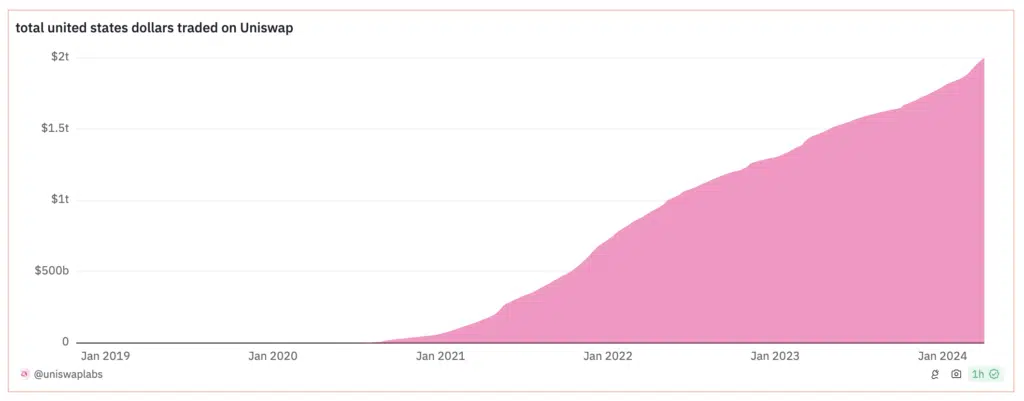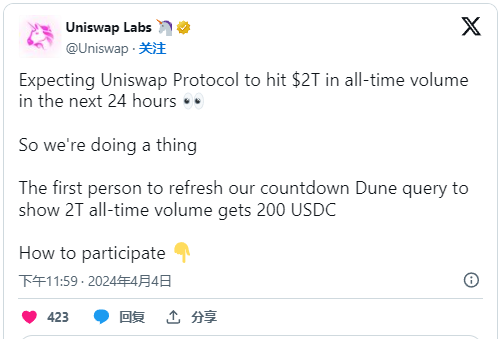Uniswap's total historical transaction volume reaches US$2 trillion
Apr 06, 2024 pm 06:37 PMDecentralized exchange Uniswap has seen its trading volume exceed $2 trillion since its launch five and a half years ago.
According to data from Dune Analytics, Uniswap’s trading volume crossed a significant level on April 5.

Before setting the new record, the Uniswap team released a message stating that $2 trillion in trading volume would be reached within 24 hours.
Uniswap Labs said it will transfer 200 USD tokens (USDC) to the first person to record and send the company a video clip that updated the Dune Analytics dashboard to show that Uniswap’s transaction volume has exceeded 200 million Dollar.

DefiLlama data shows that Uniswap ranks first among all decentralized exchanges (DEX) in terms of trading volume, with a market share of 31.5%. Uniswap’s closest competitor, PancakeSwap, has a market share of 14.6%, less than half of Uniswap’s.
Uniswap’s native token UNI reacted to this new achievement by falling. Over the past 24 hours, the coin has lost 4.5% to $10.73. The cryptocurrency’s total market capitalization also fell by the same amount, falling to $6.4 billion, according to CoinMarketCap.
Uniswap announced a new incentive strategy for UNI token holders in February 2022. The company plans to distribute tokens generated by protocol transactions to UNI token holders who actively participate in the protocol management process. The Uniswap Foundation will continue to control key parameters related to tokens.
The above is the detailed content of Uniswap's total historical transaction volume reaches US$2 trillion. For more information, please follow other related articles on the PHP Chinese website!

Hot AI Tools

Undress AI Tool
Undress images for free

Undresser.AI Undress
AI-powered app for creating realistic nude photos

AI Clothes Remover
Online AI tool for removing clothes from photos.

Clothoff.io
AI clothes remover

Video Face Swap
Swap faces in any video effortlessly with our completely free AI face swap tool!

Hot Article

Hot Tools

Notepad++7.3.1
Easy-to-use and free code editor

SublimeText3 Chinese version
Chinese version, very easy to use

Zend Studio 13.0.1
Powerful PHP integrated development environment

Dreamweaver CS6
Visual web development tools

SublimeText3 Mac version
God-level code editing software (SublimeText3)

Hot Topics
 How to get stablecoin USDT for free_Xiaobai stablecoin USDT obtain guide
Jul 15, 2025 pm 11:51 PM
How to get stablecoin USDT for free_Xiaobai stablecoin USDT obtain guide
Jul 15, 2025 pm 11:51 PM
Yes, you can get USDT for free in the following 5 ways: 1. Participate in airdrop tasks on mainstream exchanges, such as registering and giving away, completing novice tasks, and inviting friends to get rewards; 2. Join the blockchain project community and obtain airdrops through Web3 social platform or Twitter/Discord interaction; 3. Participate in the "test network" activity, register the test chain address and simulate the use of DApp to get incentives; 4. Complete tasks on the cryptocurrency navigation platform to receive novice gift packages, participate in sign-in, lottery and other activities; 5. Interact with the content creation and community, and publish original content to obtain USDT rewards from the project party. At the same time, you need to pay attention to security risks, do not fill in private keys, do not believe in scams, and choose mainstream platforms to participate.
 Is the stablecoin USDT a scam? Is the company behind the stablecoin USDT reliable?
Jul 15, 2025 pm 11:57 PM
Is the stablecoin USDT a scam? Is the company behind the stablecoin USDT reliable?
Jul 15, 2025 pm 11:57 PM
USDT is not a scam, but there are risks. 1. Tether provides liquidity in the crypto market by issuing USDT, a stablecoin anchored by the US dollar; 2. The company's background is related to Bitfinex, and has been fined for audit issues but has increased transparency; 3. The reserve assets are mainly US Treasury bonds rather than pure cash, and there are certain financial risks; 4. Face risks such as insufficient audit frequency, centralized control and compliance restrictions; 5. The USDT market is highly accepted, but trust needs to be based on continuous disclosure and compliance operations. Overall, USDT is trustworthy but does not equal zero risk, and users should be cautious.
 LayerZero, StarkNet, ZK Ecological Preheat: How long can the airdrop bonus last?
Jul 16, 2025 am 10:06 AM
LayerZero, StarkNet, ZK Ecological Preheat: How long can the airdrop bonus last?
Jul 16, 2025 am 10:06 AM
The duration of the airdrop dividend is uncertain, but the LayerZero, StarkNet and ZK ecosystems still have long-term value. 1. LayerZero achieves cross-chain interoperability through lightweight protocols; 2. StarkNet provides efficient and low-cost Ethereum L2 expansion solutions based on ZK-STARKs technology; 3. ZK ecosystem (such as zkSync, Scroll, etc.) expands the application of zero-knowledge proof in scaling and privacy protection; 4. Participation methods include the use of bridging tools, interactive DApps, participating test networks, pledged assets, etc., aiming to experience the next generation of blockchain infrastructure in advance and strive for potential airdrop opportunities.
 How to transfer USDT to the exchange of stablecoin_Detailed explanation of USDT exchange trading operations
Jul 15, 2025 pm 11:36 PM
How to transfer USDT to the exchange of stablecoin_Detailed explanation of USDT exchange trading operations
Jul 15, 2025 pm 11:36 PM
To transfer USDT to the exchange for transactions, you must first confirm that the chain type matches, the address is correct, and complete real-name authentication. 1. Register and authenticate the mainstream exchange account with real name; 2. Confirm that the wallet is consistent with the USDT chain type of the exchange (such as TRC20); 3. Obtain the recharge address of the corresponding chain on the exchange and copy it accurately; 4. Initiate transfers from the wallet and pay the corresponding handling fee; 5. After arrival, you can trade in the spot or contract market; 6. Pay attention to checking the address, avoid transferring to the contract address, and give priority to low-processing networks. The entire process is usually completed in minutes, ensuring operational safety is key.
 How much is a stablecoin USD
Jul 15, 2025 pm 09:57 PM
How much is a stablecoin USD
Jul 15, 2025 pm 09:57 PM
The value of stablecoins is usually pegged to the US dollar 1:1, but it will fluctuate slightly due to factors such as market supply and demand, investor confidence and reserve assets. For example, USDT fell to $0.87 in 2018, and USDC fell to around $0.87 in 2023 due to the Silicon Valley banking crisis. The anchoring mechanism of stablecoins mainly includes: 1. fiat currency reserve type (such as USDT, USDC), which relies on the issuer's reserves; 2. cryptocurrency mortgage type (such as DAI), which maintains stability by over-collateralizing other cryptocurrencies; 3. Algorithmic stablecoins (such as UST), which relies on algorithms to adjust supply, but have higher risks. Common trading platforms recommendations include: 1. Binance, providing rich trading products and strong liquidity; 2. OKX,
 How to identify fake altcoins? Teach you to avoid cryptocurrency fraud
Jul 15, 2025 pm 10:36 PM
How to identify fake altcoins? Teach you to avoid cryptocurrency fraud
Jul 15, 2025 pm 10:36 PM
To identify fake altcoins, you need to start from six aspects. 1. Check and verify the background of the materials and project, including white papers, official websites, code open source addresses and team transparency; 2. Observe the online platform and give priority to mainstream exchanges; 3. Beware of high returns and people-pulling modes to avoid fund traps; 4. Analyze the contract code and token mechanism to check whether there are malicious functions; 5. Review community and media operations to identify false popularity; 6. Follow practical anti-fraud suggestions, such as not believing in recommendations or using professional wallets. The above steps can effectively avoid scams and protect asset security.
 Is USDT worth investing in stablecoin_Is USDT a good investment project?
Jul 15, 2025 pm 11:45 PM
Is USDT worth investing in stablecoin_Is USDT a good investment project?
Jul 15, 2025 pm 11:45 PM
USDT is not suitable as a traditional value-added asset investment, but can be used as an instrumental asset to participate in financial management. 1. The USDT price is anchored to the US dollar and does not have room for appreciation. It is mainly suitable for trading, payment and risk aversion; 2. Suitable for risk aversion investors, arbitrage traders and investors waiting for entry opportunities; 3. Stable returns can be obtained through DeFi pledge, CeFi currency deposit, liquidity provision, etc.; 4. Be wary of centralized risks, regulatory changes and counterfeit currency risks; 5. In summary, USDT is a good risk aversion and transitional asset. If you pursue stable returns, it should be combined with its use in financial management scenarios, rather than expecting its own appreciation.
 How to calculate the altcoin transfer fee? Analysis of cost differences between different chains
Jul 15, 2025 pm 10:54 PM
How to calculate the altcoin transfer fee? Analysis of cost differences between different chains
Jul 15, 2025 pm 10:54 PM
The altcoin transfer fee varies from chain to chain and is mainly determined by the basic network fee, transaction speed and Gas unit. 1. The Ethereum fee is high, with an average of US$2~20 per transaction, suitable for high-value transactions; 2. The Binance Smart Chain fee is low, about US$0.1~0.3, suitable for daily operations; 3. The Solana fee is extremely low, usually below US$0.0001, suitable for high-frequency transactions; 4. The Polygon fee is less than US$0.01, compatible with EVM; 5. TRON focuses on low-cost, and the handling fee is almost negligible. Users should reasonably choose the transfer method based on the characteristics of the chain, network congestion and gas fluctuations, and at the same time confirm that the token belongs to the same link as the receiver to avoid asset losses.





